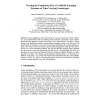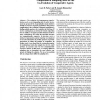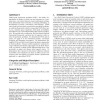6 search results - page 1 / 2 » Varying the Population Size of Artificial Foraging Swarms on... |
ICANN
2005
Springer
13 years 10 months ago
2005
Springer
Abstract. Swarm Intelligence (SI) is the property of a system whereby the collective behaviors of (unsophisticated) entities interacting locally with their environment cause cohere...
CEC
2003
IEEE
13 years 10 months ago
2003
IEEE
Abstract -_The evolution of a heterogeneousteam behavior can he a very demanding task. In order to promote the greatest level of specialization team members should be evolved in se...
CEC
2005
IEEE
13 years 11 months ago
2005
IEEE
A grouping genetic algorithm (GGA) for the university course timetabling problem is outlined. We propose six different fitness functions, all sharing the same common goal, and look...
CEC
2005
IEEE
13 years 11 months ago
2005
IEEE
The most controversial part of genetic programming is its highly disruptive and potentially innovative subtree crossover operator. The clearest problem with the crossover operator...
ATAL
2007
Springer
13 years 9 months ago
2007
Springer
Multi-Agent Agreement problems (MAP) - the ability of a population of agents to search out and converge on a common state - are central issues in many multi-agent settings, from d...



